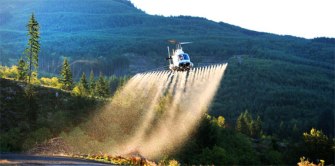Dear Skykomish Valley Residents,

Photo courtesy of WA State DNR
We would like to remind you about upcoming season of wildfire and toxic spraying, and to share with you available information for safety.
SUMMARY FOR TOXIC PESTICIDE SPRAYING IN THE SKYKOMISH RIVER VALLEY
WA State DNR NW: end toxic spraying in Sky Valley! page
Summary of DNR Silviculture Contracts has information for ground-based pesticide spraying by DNR. DNR Ground Herbicide Contract 1724 and Maps, July 16 – September 14, 2018; 1998 acres total for Northwest Region, 214 acres for the Skykomish River Valley. Some ground spray ingredients include Glyphosate, Imazapyr, Tryclopir, Sulphometuron Methyl, Metsulphuron Methyl.
PLEASE SHARE: We encourage you to send a request to DNR Northwest Region that it ends toxic pesticide spraying on public forestslands in the watershed and the highly-active tourism/recreation zone of the Skykomish River Valley. DNR Northwest Region should instead use manual or mechanical control of unwanted vegetation on those public forestlands. Please write a short message to northwest.region@dnr.wa.gov or quickly fill the contact form below. Your message will go directly to DNR Northwest Region.
You are welcome to write your own message or copy and paste this prompt in the contact form:
I respectfully request that DNR Northwest Region ends toxic pesticide spraying on public forestslands in the watershed and the highly-active tourism/recreation zone of the Skykomish River Valley and that DNR Northwest Region uses instead manual or mechanical control of unwanted vegetation on those public forestlands.
Some facts for toxic pesticide spraying: Timber corporations and DNR may aerially or manually spray pesticides on recently harvested or recently re-planted industrial tree plantations every year in spring or fall in dry, fairly calm weather. Nevertheless, PESTICIDES OFTEN DRIFT AND RELOCATE IN AIR, SOIL, AND WATER. Pesticides are applied in areas along the Western U.S. and beyond on a massive scale.

Photo courtesy of WA State DNR
The EPA registers chemicals for use nationally, however registration does NOT guarantee safety. The WA State Department of Agriculture is the regulatory agency in charge of enforcing laws regarding the use of pesticides in WA State.
Aerial pesticide spraying on tree plantations requires permits by DNR (Department of Natural Resources). Meanwhile, ground pesticide spraying does not require any permits. FPA (Forest Practice Application) for aerial pesticide spraying is valid for 3 years. Aerial spraying can take place at any time during those 3 years from the date of approval. The same area can be sprayed more than once during those 3 years.
Some forest landowners notify adjacent property owners in advance of an aerial spray, but it is not required by law. It is worth asking for such information, if sprays are planned nearby.
Chapter 35.88 RCW “Water Pollution—Protection From”
RCW 70.54.010 “Polluting Water Supply – Penalty”
What to do before, during and after toxic aerial spraying

Sunset Falls, Skykomish River Valley
SUMMARY FOR THE LATEST FPAs (FOREST PRACTICE APPLICATIONS)
Contact List for Toxic Sprays and Contact List for Press and Elected Officials
February 27, 6 pm in Everett – next public meeting of Reiter Foothills Public Forum.
Warm regards,
SVENA Team
svena.org
